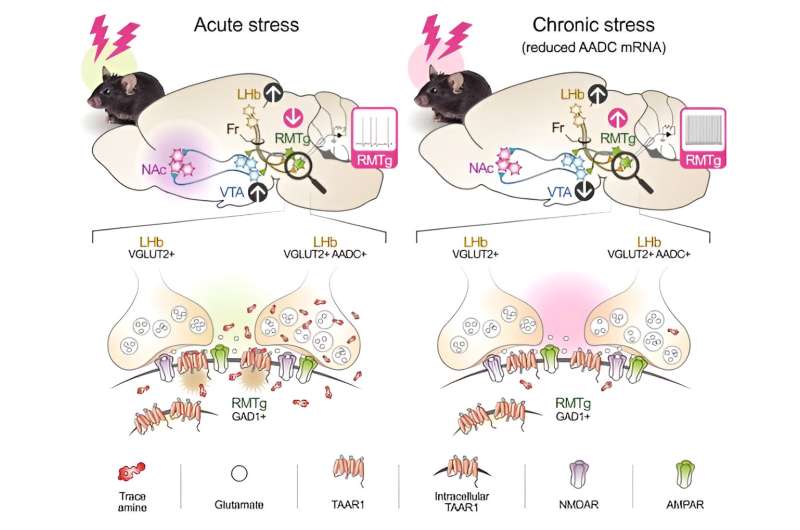This article has been reviewed according to Science X's editorial process and policies. Editors have highlighted the following attributes while ensuring the content's credibility:
fact-checked
peer-reviewed publication
proofread
Research identifies signaling mechanism that suppresses depressive symptoms caused by daily stress

Professor Hyun Kim and his team from the Department of Anatomy, College of Medicine, Korea University, have identified the inherent mechanism that suppresses the induction of depressive symptoms caused by stress through research on the control of the neural network of trace amines in the lateral habenula and the analysis of depressive behaviors.
This research was published under the title "Neural mechanism of acute stress regulation by trace aminergic signaling in the lateral habenula in male mice" in Nature Communications.
Continuous stress is known to induce depressive symptoms. Stress drives depression by exciting glutamatergic neurons in the lateral habenula and activating GABAergic neurons in the lateral tegmental nucleus, which silences dopaminergic neurons. However, daily stress causes activation of glutamatergic neurons in the lateral habenula, but depressive symptoms do not occur. Many researchers have suggested a theory of an inherent system that offsets the triggering of depressive symptoms, but the reason has not been clearly proven to date.
To investigate the theory, Professor Hyun Kim's research team analyzed the close relationship between trace aminergic signaling and the induction of depressive symptoms through research on the control of the neural network of trace amines in the lateral habenula and the analysis of depressive behaviors.
The team observed a specific decrease in AADC (L-amino acid decarboxylase) gene expression, which produces trace amines in the lateral habenula of a stress-based depressed animal model, and the fact that artificially reducing AADC expression in the lateral habenula induces depressive symptoms. Restoring the reduced AADC gene expression alleviated depressive symptoms.
With daily stress, the lateral habenula secretes trace amines to offset the effect of glutamatergic neuron activation, and no depressive symptoms appear. But under constant stress, glutamatergic signaling is superior to trace aminergic signaling and causes depressive symptoms. This allowed the team to confirm that trace aminergic signaling acts as an inherent system that offsets the effect of glutamatergic neuron activation in everyday stress situations.
The team leader, Professor Hyun Kim, said, "Our research has identified that trace aminergic signaling in the lateral habenula acts as an inherent system that controls the effects of glutamatergic neuron activation. This suggests a new direction for the prevention and treatment of depression."
More information: Soo Hyun Yang et al, Neural mechanism of acute stress regulation by trace aminergic signalling in the lateral habenula in male mice, Nature Communications (2023). DOI: 10.1038/s41467-023-38180-7



















